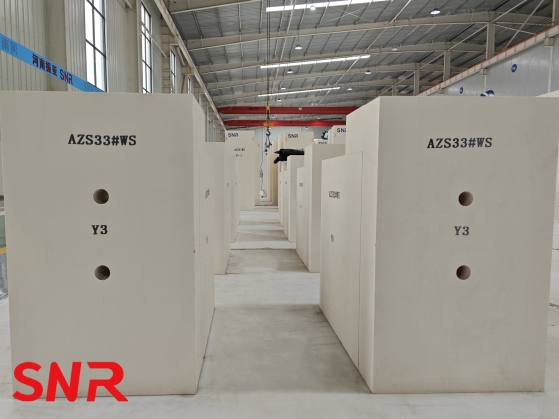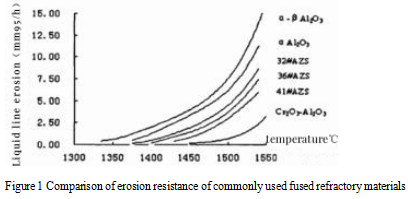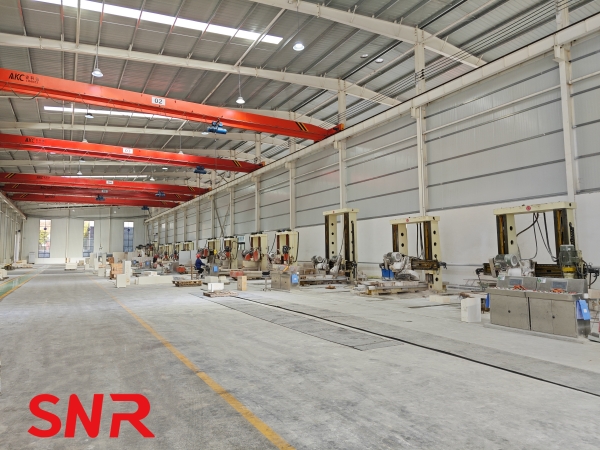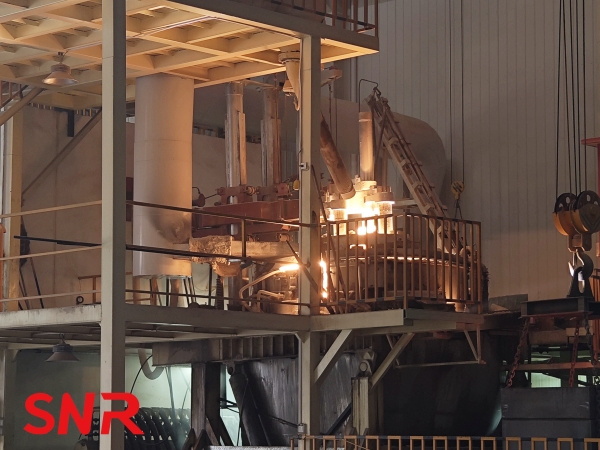
Fused cast zirconia corundum brick is a kind of refractory material with alumina (Al2O3) and zirconia (ZrO2) as the main components, which is prepared by high-temperature molten casting molding process. Because of its high melting point, hardness, excellent corrosion resistance, and thermal shock resistance, fused cast zirconium corundum brick is widely used in high-temperature industrial equipment such as glass furnaces. With the continuous development of high-temperature industrial technology, the performance requirements of refractory materials are increasing daily. It is of great significance to study the influence of the composition and structure of fused cast zirconium corundum brick on its performance for optimizing material properties and developing new refractory materials.
Based on the composition and structure of fused cast zirconium corundum brick, the mechanism of its influence on material properties is systematically discussed in this paper. Firstly, the main components and their functions of fused cast zirconium corundum brick are introduced, and the effects of different components on material properties are analyzed. Secondly, the microstructure of fused cast zirconium corundum brick is described, including crystal phase composition, grain boundary structure, etc., and the relationship between the microstructure and material properties is discussed. Finally, the influence mechanism of composition and structure on properties of fused cast zirconium corundum brick is summarized.
1. Composition of fused cast zirconium corundum brick and its influence on performance
1.1 Main Components
The main components of fused cast zirconium corundum bricks include alumina (Al2O3) and zirconium oxide (ZrO2), and usually contain a small amount of impurities such as silicon dioxide (SiO2) and sodium oxide (Na2O). Among them, the content of alumina and zirconia directly affects the performance of the material.
Alumina (Al2O3) : Alumina is one of the main components of fused cast zirconium corundum brick, with high melting point (2054℃) and high hardness, can provide excellent high temperature strength and erosion resistance. The higher the content of alumina, the better the refractoriness and erosion resistance of the material, but too high alumina content may lead to a decrease in the thermal shock resistance of the material.
Zirconia (ZrO2) : Zirconia is the other main component of fused cast zirconium corundum brick, with a high melting point (2715 ℃) and excellent thermal stability. The presence of zirconia can significantly improve the thermal shock resistance and corrosion resistance of the material, especially at high temperatures, the phase transition toughening mechanism of zirconia can effectively improve the fracture toughness of the material.
Impurity components (SiO2, Na2O, etc.) : Although the content of impurity components is small, it also has an important impact on the performance of the material. Impurities such as silica and sodium oxide generally reduce the refractoriness and erosion resistance of the material, especially at high temperatures, where these impurities may form a low melting point phase, resulting in a decrease in the high temperature performance of the material.
1.2 Impact of Components on Performance
The composition of fused cast zirconium corundum brick has a direct impact on its performance, mainly reflected in the following aspects:
Corrosion resistance: The corrosion resistance of fused cast zirconium corundum brick mainly depends on the content of alumina and zirconia. Alumina has excellent resistance to acid and alkali erosion, while zirconia can effectively resist the erosion of glass melt and metal slag. Therefore, appropriately increasing the content of alumina and zirconia can significantly improve the erosion resistance of the material.
Thermal shock resistance: The phase change toughening mechanism of zirconia is the key to improving the thermal shock resistance of fused cast zirconium corundum brick. At high temperatures, zirconia will undergo a phase transition from the monoclinic phase to the tetragonal phase, which will absorb energy and improve the fracture toughness of the material. Therefore, appropriately increasing the content of zirconia can effectively improve the thermal shock resistance of the material.
High-temperature strength: The high melting point and hardness of alumina provide excellent high-temperature strength for fused cast zirconium corundum bricks. However, too high alumina content may lead to increased brittleness of the material and decreased thermal shock resistance. Therefore, in practical applications, it is necessary to adjust the ratio of alumina and zirconia reasonably according to the specific conditions of use to achieve the best high-temperature strength.
2. Performance of fused cast zirconium corundum brick
2.1 Relation between conductivity and temperature of fused zirconium corundum brick
For fused cast zirconium corundum brick, its performance needs to be continuously improved. At present, the application of fusible cast refractories in glass melting furnaces can not only improve the high-temperature performance of products but also needs to have excellent resistance to glass liquid and steam corrosion. As a functional material, fusible cast refractories constitute a reasonable three-dimensional space of a glass melting furnace. The life of modern glass melting furnaces is required to reach more than 5 years, and some even exceed 12 years. At present, no material can replace the special position of fusing cast refractories in glass-melting furnaces. On the one hand, the fused cast zirconium corundum brick shows excellent fire resistance in the manufacturing process, and the fused casting process is convenient for its forming; On the other hand, there are almost no open pores in the fused casting material, which significantly reduces the passage of glass liquid into the refractory, thus greatly improving the corrosion resistance of the material. Therefore, the fused casting material has characteristics that ordinary materials cannot match. When analyzing the corrosion resistance of fusible cast refractory, it is necessary to study the influence of its composition and structure on the performance.

 As shown in Figure 1, the erosion results of commonly used fusible casting materials were analyzed after holding Na₂O-CaO-SiO glass as a melt at a specific temperature for 95 hours. The experimental results show that AZS refractory has excellent resistance to glass erosion. However, in the process of analysis, it is also found that there is inhomogeneity in its macro structure and microstructure, which are mainly reflected in physical properties, such as volume and density.
As shown in Figure 1, the erosion results of commonly used fusible casting materials were analyzed after holding Na₂O-CaO-SiO glass as a melt at a specific temperature for 95 hours. The experimental results show that AZS refractory has excellent resistance to glass erosion. However, in the process of analysis, it is also found that there is inhomogeneity in its macro structure and microstructure, which are mainly reflected in physical properties, such as volume and density.
3. Structure of fused cast zirconium corundum brick and its influence on performance
3.1 Microstructure characteristics
The microstructure of fused cast zirconium corundum brick is mainly determined by crystal phase composition, grain boundary structure, and pore distribution. These microstructure characteristics have an important effect on the properties of materials.
Crystal phase composition: The main crystalline phases of fused cast zirconium corundum brick are corundum phase (α-Al2O3) and clinozircon phase (m-ZrO2). The corundum phase has high hardness and high melting point, which can provide excellent high-temperature strength and erosion resistance. The clinozircon phase improves the thermal shock resistance of the material by phase transition toughening mechanism. In addition, there may also be a small amount of glass phases in the material, which are often formed by impurity components and can adversely affect the properties of the material.
Grain boundary structure: The grain boundary is the interface area between the grains in fused cast zirconium corundum brick, and the grain boundary structure has an important effect on the mechanical properties and erosion resistance of the material. The impurity composition and glass phase at the grain boundary may cause the grain boundary strength to decrease, thus affecting the high-temperature performance of the material. Therefore, reducing the impurity content at the grain boundary and optimizing the grain boundary structure are important ways to improve the material properties.
Porosity distribution: Porosity is an unavoidable microstructure feature in fused cast zirconium corundum brick. The number, size, and distribution of porosity have an important effect on the properties of the material. The existence of pores will reduce the density and strength of the material, but the right amount of pores can improve the thermal shock resistance of the material. Therefore, in actual production, the number and distribution of pores need to be controlled to achieve the best performance balance.
3.2 Influence of structure on performance
The microstructure of fused cast zirconium corundum brick has an important impact on its performance, which is mainly reflected in the following aspects:
Erosion resistance: Grain boundary structure and pore distribution have an important effect on the erosion resistance of the material. The impurities and glass phase at the grain boundary may become the channels for the penetration of the corrosive medium, thus reducing the erosion resistance of the material. In addition, the existence of pores may also provide infiltration paths for erosive media. Therefore, reducing the impurity content at the grain boundary and optimizing the porosity distribution can improve the erosion resistance of the material.
Thermal shock resistance: The presence of pores can improve the thermal shock resistance of the material because the pores can absorb thermal stress and reduce the spread of cracks. However, too many pores can reduce the strength and erosion resistance of the material. Therefore, in practical applications, it is necessary to reasonably control the number and distribution of pores according to the specific conditions of use to achieve the best thermal shock resistance.
High-temperature strength: Grain boundary structure and porosity distribution have important effects on the high-temperature strength of materials. Impurities and glass phases at grain boundaries may lead to a decrease in grain boundary strength, thus affecting the high-temperature strength of the material. In addition, the presence of pores also reduces the density and strength of the material. Therefore, reducing the impurity content at the grain boundary and optimizing the porosity distribution can improve the high-temperature strength of the material.
4. Optimization of composition and structure of fused cast zirconium corundum brick
4.1 Composition Optimization
Further improve the performance of fused cast zirconium corundum brick, can be achieved by optimizing its composition. Specific measures include:
Adjust the ratio of alumina and zirconia: According to the specific conditions of use, reasonably adjust the ratio of alumina and zirconia, to achieve the best corrosion resistance, thermal shock resistance, and high-temperature strength. For example, the fused cast zirconium corundum brick used in glass furnaces can be appropriately increased in zirconia content to improve its resistance to glass melt erosion.
Reduce impurity content: By optimizing raw material selection and preparation process, reduce impurity content in materials, especially low melting point impurities such as silica and sodium oxide, to improve the refractoriness and corrosion resistance of materials.

4.2 Structure Optimization
In addition to composition optimization, the properties of fused cast zirconium corundum bricks can also be improved by optimizing their microstructure. Specific measures include:
Optimization of grain boundary structure: By adding appropriate amount of grain boundary modifier, reduce the impurity content at the grain boundary and optimize the grain boundary structure to improve the mechanical properties and erosion resistance of the material.
Control stomata distribution: By adjusting the preparation process, control the number and distribution of stomata to achieve the best thermal shock resistance and high temperature strength. For example, the vacuum casting process can be used to reduce the porosity in the material and improve the density and strength of the material.
The composition and structure of fused cast zirconium corundum brick have important influence on its properties. The corrosion resistance, thermal shock resistance and high temperature strength of the material can be significantly improved by adjusting the proportion of alumina and zirconia reasonably, reducing the impurity content, optimizing the grain boundary structure and porosity distribution. In the future, with the continuous development of high temperature industrial technology, the composition and structure optimization of fused cast zirconium corundum brick will continue to become a research hotspot to meet the increasing performance requirements.
Henan SNR Refractory Co., Ltd (SNR), as the world's professional refractory supplier, has always been committed to providing customers with high-quality fused cast AZS block products. Our fused cast AZS blocks adopt advanced melting and casting technology, and strictly control the proportion of raw materials and preparation process, to ensure that the products have excellent fire resistance, corrosion resistance, thermal shock resistance, and mechanical strength. SNR fused cast AZS block has been widely used in the world's major glass manufacturing enterprises, and has won the praise of customers.

If you are looking for high-performance, high-reliability fused cast AZS block products, SNR company will be your best choice. We have a professional technical team and a perfect after-sales service system, that can provide you with a full range of solutions and technical support. Please contact us for more information about SNR fused cast AZS blocks.
Web:www.snrefractory.com
Email:moon@snrefractory.com